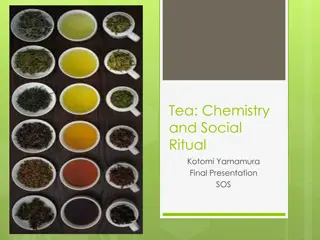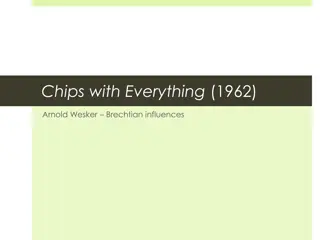Experience Traditional Japanese Culture: Tea Ceremony, Ikebana, Kimono, and Theatre
Dive into the rich traditions of Japanese culture through the immersive experiences of the Tea Ceremony, Ikebana flower arranging, wearing a Kimono, and witnessing the captivating performances of Japanese theatre. Explore the elegance and mindfulness embedded in these practices, each offering a unique glimpse into Japan's cultural heritage.
Download Presentation

Please find below an Image/Link to download the presentation.
The content on the website is provided AS IS for your information and personal use only. It may not be sold, licensed, or shared on other websites without obtaining consent from the author.If you encounter any issues during the download, it is possible that the publisher has removed the file from their server.
You are allowed to download the files provided on this website for personal or commercial use, subject to the condition that they are used lawfully. All files are the property of their respective owners.
The content on the website is provided AS IS for your information and personal use only. It may not be sold, licensed, or shared on other websites without obtaining consent from the author.
E N D
Presentation Transcript
Tea Ceremony Tea Ceremony is one of the Japanese things visitors from overseas. Although some may think that the English are the world champion tea drikers, the Japanese take it one step farther.They ceremony of ceremony was perfected by Sen- no-Rikyu in the 16 th century, but its origin goes back many years before.Closely associated the sect of ceremony is supposed to create peace of mind in both the peformer and partaker. that fascinates make a drinkig.The tea with the Buddhism,
Tea Ceremony Here is how it is done... powdered green tea is scooped up with a small bamboo ladle and put in a deep bowl. Hot water is poured over the tea and a bamboo whisk is used to whip the mixture to a froth.The tea is then drunk by the participants. It is proper etiquette to drink slowly.The best way is to crandle the cup in your left hand, turn it slowly three times,with grasping the rim. Drink slowly, preferably in three or four sips. Then place the cup gently on the tatarni floor before you. It is proper etiquette to examine the cup,but not too closely, and to remark on its elegance.Simplicity and elegance are essential in the tea ceremony. your right hand
Ikebana Ikebana,the arranging, is one unique cultural heritage you will encounter in Japan .Born in the Muromachi period [1338-1573] when the tea ceremony began to take hold among high-ranking samurai,its simplicity is of necessity,as there was only a small space in the tiny teahouse for flowers. Today, there are three or four thousand ifferent ikebana schools with millions of adherents. There are two basic themes that are common to schools -the formal and the natural. The formal method bases its teaching components in representations of Heaven, Earth and Man. The natural method emphasizes the simplicity of the flower itself art of flower on three arrangement, main any
Kimono Foreign visitors are often disappointed to that few Japanese particularly in the cities. The reason is simple. A kimono is not only expensive, but also is not easy to wear in this modern age as Western clothes. Kimono patterns and colours are different, but cutting and style are almost uniform. Material is cotton or manmade fabric for everyday use, but the more expensive kimono is of silk. Accessories include an obi [sash] and haori [a short overcoat]. Other accessories that go with the kimono are juban [underwear made of silk or cotton]; smaller sashes; split-toed tabi socks; and zori or geta, footwear. Zori are often used for formal occasions. Geta are informal and almost never worn on formal occasions. The yukata is a gay cotton kimono and quite relaxing to wear. At a Japanese inn, you will have a chance to wear a yukata. learn wear kimono,
Japanese theatre Japanese theatre is represented, first of all, by traditional theatres Kabuki, Noh Drama and a puppet- show Bunraku. Noh Noh is characterised by the use of masks and by stately dancing and singing to the accompaniment of instrumental "Noh" simply means "performance", and evolved from sarugaku, a form of entertainment that was popular in the 13-th and 14-th centuries.Sarugaku was refined by Kannami Kiyotsugu(1333-1384) and his son Zeami Motokiyo(1363-1443) gave noh its present character. The subjects of noh plays are mostly historical and show Buddhist influece. The noh stage, 5,5 meters (18-feet ) square, is much smaller than the kabuki sage and is covered with an inner roof The stage set usually just a huge pine tree painted on a backdrop. Noh costumes are gorgeous and their effect is doubled on the bare noh stage.Masks,which take the place of the make-up used in other forms of dramatic art, are worn by the acto to indicate the characters portrayed. The language,costumes and settings have not changed scince the 16-th centuary.Even today, noh audiences are mainly connoisseurs of the art rather than people seeking entertainment. musc. is simple,























